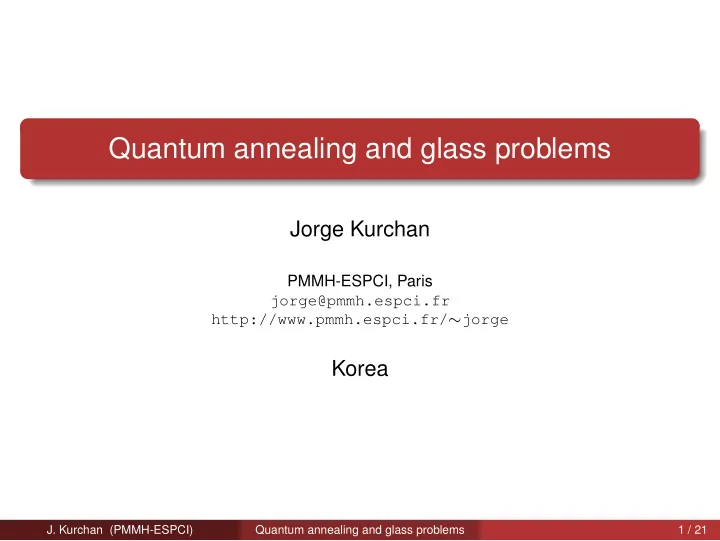

Quantum annealing and glass problems Jorge Kurchan PMMH-ESPCI, Paris jorge@pmmh.espci.fr http://www.pmmh.espci.fr/ ∼ jorge Korea J. Kurchan (PMMH-ESPCI) Quantum annealing and glass problems 1 / 21
with: Thomas J¨ org, Florent Krzakala, and Anthony C. Maggs J. Kurchan (PMMH-ESPCI) Quantum annealing and glass problems 2 / 21
Quantum Computing Factorizing numbers: exponential → polynomial Finding one out of e N objects → e N/ 2 Hard Problems (NP-complete) in the worse case, ... their random realizations Graph Coloring, Satisfaction, → ????? Spin-Glass ground states... J. Kurchan (PMMH-ESPCI) Quantum annealing and glass problems 3 / 21
Quantum Annealing N H ( { σ } ) = E ( { σ z } ) + Γ � σ x i = H 0 + Γ V (1) i =1 Staying in the lowest level without de-railing requires speed ∆ − 2 Eo Γ J. Kurchan (PMMH-ESPCI) Quantum annealing and glass problems 4 / 21
T h Fat and small versus thin and tall... J. Kurchan (PMMH-ESPCI) Quantum annealing and glass problems 5 / 21
Imaginary time Shroedinger ... Γ ∂ 2 � � ˙ P = − + V ( x ) ∂x i ... is ‘Darwinian’ optimization CLONING RATE ~ V(x) Γ DIFFUSION ~ J. Kurchan (PMMH-ESPCI) Quantum annealing and glass problems 6 / 21
Adiabatic Quantum Computation is Equivalent to Standard Quantum Computation (Aharonov et al) The speed is directly given by the minimal gap. J. Kurchan (PMMH-ESPCI) Quantum annealing and glass problems 7 / 21
If you know where the crossing takes place, you gain a square root −2 −2 ∆ . ∆ speed ~ ∆ 2 time’ ~ = time time ~ ∆ ∆ ∆ ∆ if you know where the crossing is ... J. Kurchan (PMMH-ESPCI) Quantum annealing and glass problems 8 / 21
Grover Finding a needle in a haystack, if you know its color... [ ] [ ] 0 1 1 1 ... ... ... 1 0 1 ............... .......... .... 1 0 1 Γ − 0 −1 0 0 1 1 .... .......... ..... 1 1 0 WHERE IS THE −1 ? √ From N to N , non-trivial yet non miraculous... J. Kurchan (PMMH-ESPCI) Quantum annealing and glass problems 9 / 21
The Random Energy Model. Energies are independent Gaussian random numbers. Can be realized with a p -spin model, with large p E ( { σ z } ) = lim p →∞ i 1 ,...,i p J i 1 ,...,i p σ z i 1 ...σ z � i p J. Kurchan (PMMH-ESPCI) Quantum annealing and glass problems 10 / 21
Entropy 1/Τ 0 Energy T paramagnet quantum paramagnet spin−glass Γ J. Kurchan (PMMH-ESPCI) Quantum annealing and glass problems 11 / 21
� 1 Γ 2 V ik V ki + . . . = E i + N Γ 2 � � E i (Γ) = E i + Γ V ii + + O E i (Γ) − E k E i N k � = i E=0 E~O(N) J. Kurchan (PMMH-ESPCI) Quantum annealing and glass problems 12 / 21
To leading order in N there is no corection to eigenvectors or eigenvalues. The same is true on the other side of the transition. everything happens at the (first order) transition, where the eigenvectors suddendly ‘find’ the solution J. Kurchan (PMMH-ESPCI) Quantum annealing and glass problems 13 / 21
1.4 REM ’unfrozen’ f=-T(ln(2)) 1/2 -1/4T 1.2 Quantum Paramagnet f=-T ln(2) -T ln cosh( Γ /T) 1 0.8 T Glass transition 0.6 1 st order quantum transition 0.4 REM ’frozen’ f=-(ln2) 1/2 0.2 0 0 0.2 0.4 0.6 0.8 1 1.2 Γ J. Kurchan (PMMH-ESPCI) Quantum annealing and glass problems 14 / 21
To compute the gap, we just have to diagonalise: H| φ � = [ E o | SG �� SG | − Γ N | QP �� QP | ] | φ � = λ | φ � The gap is exponentially small ∆ min ( N ) = 2 | E o | 2 − N/ 2 J. Kurchan (PMMH-ESPCI) Quantum annealing and glass problems 15 / 21
N=20, 5 lowest eigenvalues -14 -16 -18 -20 1 E n ( Γ ) -22 Gap min (N) 0.1 -24 0.01 -26 0.001 8 10 12 14 16 18 20 22 24 -28 N -30 0 0.2 0.4 0.6 0.8 1 1.2 Γ J. Kurchan (PMMH-ESPCI) Quantum annealing and glass problems 16 / 21
Generic Random First Order random p > 2 -spin, Potts, etc etc 1.0 0.8 QP > QP < T 0.6 0.4 QG 0.2 0.0 0.0 0.2 0.4 0.6 0.8 1.0 Γ J. Kurchan (PMMH-ESPCI) Quantum annealing and glass problems 17 / 21
Suzuki-Trotter + Replica Approach Order parameter: q µν ( t, t ′ ) A replicated closed polymer in a random potential! J. Kurchan (PMMH-ESPCI) Quantum annealing and glass problems 18 / 21
One-step RSB ansatz q d tt’ q tt’ 0 q µµ ’ = . .. tt’ 0 m J. Kurchan (PMMH-ESPCI) Quantum annealing and glass problems 19 / 21
A two-time instanton Approach d q (t,t’) , q (t,t’) t1 t2 t3 t (1,1) (1,2) (1,1) (1,2) t’1 (2,1) (2,2) (2,1) (2,2) t’2 (1,2) (1,1) (1,2) (1,1) t’3 (2,1) (2,2) (2,1) (2,2) t’ quantum spin−glass paramagnet J. Kurchan (PMMH-ESPCI) Quantum annealing and glass problems 20 / 21
In general, the Gap is (minus) the exponential of the free-energy cost of a two-tme wall It is hence the exponential of a negative extensive quantity One can easily recover the result of the REM J. Kurchan (PMMH-ESPCI) Quantum annealing and glass problems 21 / 21
In conclusion, this class of hard problems remains exponentially hard in Quantum Annealing We now know how to adapt the spin-glass technology to compute the Gaps, and hence the complexity. J. Kurchan (PMMH-ESPCI) Quantum annealing and glass problems 22 / 21
Recommend
More recommend